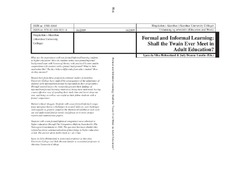Formal and informal learning. Shall the twain ever meet in adult education
Research report
Permanent lenke
http://idtjeneste.nb.no/URN:NBN:no-bibsys_brage_10503https://hdl.handle.net/20.500.12199/209
Utgivelsesdato
2009Metadata
Vis full innførselSamlinger
- Skriftserien (NY) [11]
Beskrivelse
What are the experiences with non-formal/informal learning students in higher education? How do students with a non-formal/informal background cope with lessons of theory, with practical lessons and in cooperation with students with a formal background? What is their motivation like? Do they behave differently from other student? How do they succeed? Researchers from three profession-oriented studies at Akershus University College have studied the consequences of the admittance of students with informal/non-formal backgrounds in their programmes. Through several essays the researches present their findings of informal/non-formal learning students as being more motivated, having a more effective way of spending their study time and lower drop-out rate, and being as well as successful as their fellow students with a formal competence. But not without struggle. Students with a non-formal/informal competence met great literacy challenges in several subjects, and challenges were equally as great to complete the theoretical syllabus as well as to use and understand foreign words and phrase or to write project reports and examinations papers. Students with a non-formal/informal competence were admitted to higher education through The Competence Reform, launched by The Norwegian Government in 2000. The question has been whether this reform has led to a democratisation of knowledge in higher education or not. The answer given in this book is – yes it has.
Utgiver
Høgskolen i AkershusSerie
Forskningsserie16
